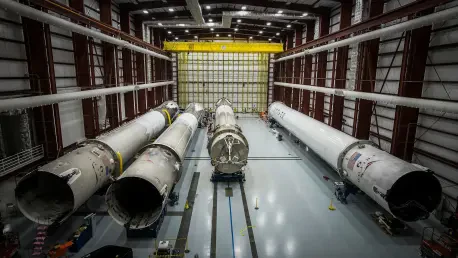In an era where space technology is advancing at an unprecedented pace, a remarkable story emerges from the University of Pittsburgh, where two students have made significant strides in satellite innovation. Dikchhya and Nischal Kharel, cousins and engineering students at the Swanson School of Engineering, have successfully developed and deployed cutting-edge applications on a geosynchronous satellite positioned over 22,000 miles above Earth. Their achievement, accomplished through a collaboration with a leading aerospace company, highlights the potential of academic-industry partnerships to address complex challenges in space research. This breakthrough not only marks a personal triumph for the students but also underscores the importance of hands-on experience in shaping the future of space engineering. Their journey offers a glimpse into how determination, mentorship, and innovative thinking can push the boundaries of what is possible in a highly technical field.
Breaking New Ground in Space Technology
Overcoming Satellite Computing Constraints
The primary challenge tackled by the Kharel cousins revolved around the severe limitations of computing power in space, particularly with small CubeSat satellites. These compact devices, often used for cost-effective space missions, are constrained by minimal resources, making it difficult to process and transmit data efficiently. Nischal Kharel focused on leveraging machine learning to compress satellite image data, a critical need for managing limited bandwidth and storage capacity. Initial tests conducted on Earth showed promising results, but the harsh realities of space—namely memory constraints—necessitated further refinements. Through close collaboration with industry experts and academic mentors, the application was adapted to function within these tight parameters, demonstrating a practical solution to a persistent problem in space data management. This effort showcases how innovative thinking can transform theoretical concepts into real-world applications, even under the most restrictive conditions.
Autonomous Data Classification in Orbit
Equally impressive was Dikchhya Kharel’s contribution to autonomous image classification directly onboard the satellite. Her machine learning model was designed to identify and prioritize relevant data, ensuring that only essential information was transmitted back to Earth. This approach significantly reduced the volume of redundant data, conserving valuable resources like bandwidth and power, which are often in short supply during space missions. Successfully deployed on a geosynchronous platform, her application marked a notable milestone in enhancing the efficiency of satellite operations. The ability to process data in orbit rather than relying solely on ground-based systems represents a shift toward more independent and intelligent satellite technology. This achievement not only highlights the potential for machine learning in space but also sets a precedent for future innovations aimed at optimizing data handling in environments where every byte counts.
The Power of Academic-Industry Collaboration
Bridging Theory and Practice Through Partnerships
A defining aspect of the Kharel cousins’ success lies in the robust partnership between the University of Pittsburgh’s NSF Center for Space, High-Performance & Resilient Computing (SHREC) and a major aerospace corporation. This collaboration provided the students with unparalleled access to advanced projects and real-world challenges, far beyond the scope of traditional classroom learning. Under the guidance of Associate Professor Samuel Dickerson and SHREC Space Center Director Alan George, along with Ph.D. student Linus Silbernagel and postdoctoral researcher Evan Gretok, the students honed their skills while working on a geosynchronous satellite system. This hands-on experience allowed them to bridge the gap between theoretical knowledge and practical application, equipping them with the tools to address complex issues in satellite technology. Such partnerships exemplify how academic institutions and industry leaders can work together to foster innovation and prepare the next generation of engineers for impactful careers.
Inspiring Future Innovators in Space Research
The broader implications of this project extend well beyond the immediate achievements of the two students. Their work serves as a powerful example of how mentorship and collaborative opportunities can inspire and train emerging talent in a field with significant technical barriers. Both Dikchhya and Nischal have since moved on to pursue graduate studies at SHREC, further deepening their expertise in space engineering. Their journey from uncertainty about future plans to achieving groundbreaking milestones reflects the transformative potential of structured research programs. Moreover, their success in optimizing machine learning applications for satellite data management points to a future where such innovations could become standard practice in space missions. This narrative underscores the value of investing in student-led research initiatives, as they not only solve pressing technological challenges but also cultivate a skilled workforce ready to tackle the unknowns of space exploration.
Looking Ahead: Shaping the Future of Space Tech
Reflecting on Milestones Achieved
Looking back, the accomplishments of Dikchhya and Nischal Kharel stand as a testament to the impact of dedication and teamwork in overcoming the formidable challenges of space technology. Their innovative applications, deployed on a geosynchronous satellite, addressed critical issues in data efficiency, proving that even resource-constrained environments can benefit from advanced machine learning solutions. The mentorship provided by seasoned academics and the collaboration with industry experts played a pivotal role in guiding their efforts to fruition. Their story captures the essence of what can be achieved when talent is nurtured through structured opportunities, turning complex problems into tangible successes that resonate across the field of space research.
Next Steps for Satellite Innovation
Moving forward, the focus should shift toward scaling such student-driven innovations to broader applications within the space industry. Encouraging more universities to establish similar partnerships with aerospace leaders can create a pipeline of talent and ideas, driving advancements in satellite technology. Additionally, investing in accessible platforms for testing and deploying student projects in real-world scenarios will be crucial for sustaining this momentum. The insights gained from these initiatives could inform the development of more efficient and autonomous satellite systems over the coming years, potentially transforming how data is managed in orbit. Emphasizing continued collaboration and mentorship will ensure that future engineers are well-equipped to push the boundaries of what space technology can achieve.









